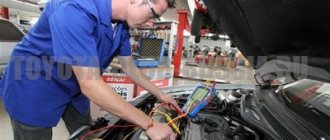Toyota Land Cruiser Prado. Description of the air suspension control system
Many Toyota Land Cruiser Prado models were equipped with rear air suspension. This type of suspension uses rubber pneumatic cylinders instead of rear springs. The main difference between this suspension is that it runs on compressed air compared to the Land Cruiser 100, which runs on a special working fluid.
Using two body height sensors, the air suspension automatically adjusts the height, depending on the number of passengers and cargo weight. In addition to automatic adjustment, you can manually set three modes of operation of this system, which significantly improves the vehicle's handling and maneuverability.
| Location of air suspension control system components. 1 — pressure modulator/ABS control unit (models without VSC), 2 — side door limit sensors, 3 — front wheel speed sensors, 4 — “AIR SUS” relay, 5 — pneumatic cylinder, 6 — body height control sensor, 7 — solenoid valve for releasing pressure in the pneumatic cylinder, 8 — control valve, 9 — bypass valve, 10 — exhaust valve, 11 — air filter housing, 12 — rear door limit switch. | |
| Location of air suspension control system components (instrument panel). 1 — suspension operating mode indicator, 2 — air suspension “OFF” indicator, 3 — air suspension control unit, 4 — vehicle control system control unit (models with VSC), 5 — diagnostic connector, 6 — brake light switch, 7 — suspension operating mode switch, 8 — switch for automatically changing the air suspension operating mode (air suspension “OFF” switch). |
The components of the rear air suspension are:
1) Air suspension operating mode switch block
Includes an automatic body height control switch (“OFF”) and an air suspension operating mode switch. There are three suspension operating mode options: “HI” (high) mode, necessary when driving off-road, “Normal” (medium) and “LO” (low) to facilitate entry/exit of passengers and when loading/unloading the vehicle.
When selecting the “HI” mode, the car body rises by approximately 30-40 mm (depending on modifications) within 15-20 seconds. When selecting the “LO” mode, the car is lowered by 30 mm relative to the normal state (within 10 - 15 seconds).
Also, in addition to manual mode switching, there is automatic mode switching:
a) If, when the car is moving in the “Normal” mode, the speed is reduced to 12 km/h or less, the suspension will automatically move to the “LO” position, and vice versa.
b) If you reduce the vehicle speed to 50 km/h (in “Normal” mode), the system will switch to “HI” mode. And if you accelerate to 50 km/h while driving in the “HI” range, the system will automatically return to the middle position.
2) Air suspension control system indicators
The suspension operating mode indicator informs the driver about the selected operating mode of the system.
The control system's "OFF" indicator lights up if the automatic air suspension control is turned off by pressing the corresponding switch. If the indicator flashes, there is a malfunction in the air suspension system. This indicator is also used to read diagnostic trouble codes.
3) Air filter assembly
It consists of the filter itself, which is necessary to clean the air taken in by the air suspension from dust and sand, and an expansion chamber, which serves to reduce noise during air intake. The air filter draws air from inside the car. He doesn't understand. If you need to replace the filter itself, replace its entire housing assembly.
4) Compressor assembly
Includes the compressor itself, the exhaust valve and the dryer.
a) The compressor supplies compressed air to the pneumatic cylinders necessary to lift the body. To avoid battery discharge, the compressor operates only when the engine is running.
Recommendations
Comments 19
I figured it out, the rear periodically sagged, and lathered and hissed, I looked for it, there was nothing, visually the airbags were in excellent condition, I decided to remove it, and only in the removed state it was clear that the entire tank was in cracks, hence the conclusion, if the car is not loaded and after starting the compressor constantly turns on , that means the pillows are being poisoned.
I also had trouble with the pneumatic, recently I started to notice that the rear of the car sags after parking at night, this has never happened before, it sags even if I turn it off, the main thing is during the day, I arrived in the morning, you leave in the evening - everything is fine, but it happens got out, 10 minutes later returned, it was noticed that he sat down, the cylinders also drain very quickly when the doors and the trunk door are open, this is how it should be or there is a malfunction and where to go to check, the cylinders were sprayed with water, no etching was noticed anywhere.
...don’t listen to anyone! People don’t know and immediately start panicking! THIS IS CALLED INTELLIGENT MODE, for boarding and disembarking passengers and cargo, it actually works a little late :-), you’ve already set the alarm and it just lowers! NO WHERE! I have the same garbage and on most cars with pneumatic air, I’ll even say more essentially, it (pneuma) itself should distinguish between speed and road surface, thereby raising or lowering the car, and when stopping and turning off the ignition, it lowers it to extreme low position MIDDLE LEVEL!
It's leaking somewhere, the car is in position n as it was and should remain, look under the car and listen
If the suspension is installed in position N, then after driving over bumps the automatic system raises it, stop, and after a couple of minutes the automatic system bleeds the air. the car lowers to position N. If the pump inflates after starting the car, the main reason is that the cylinders are poisoning, or the car body position sensor may fail.
It seems to me that this is how it should be. Before replacing the balconies, I was constantly pumping. Changed it. Now I start it with you - I pumped it up and that’s it. I turned it off for a couple of seconds and let it go. I think this is a polite landing.
Don't delay with a replacement. The compressor does not like frequent operation.
The pillows are poisoned. For replacement.
We checked the pillows at the service station. don't poison. and the mileage is only 80 thousand.
It’s unlikely that the service station can check the airbags. You won't hear any hissing. Even soapy water doesn't always help. There are microcracks in the rubber, air leaks through them, because... The pressure in the cylinders is high. The pump only pumps air, only the valve works for relief. It can also adjust the valve in the compressor itself, but this is very rare.
Many car enthusiasts complain about frequently occurring problems: in rest mode, the 120 Prado air deflates, and the car rests on the bump stops. When the engine is turned on, the compressor pumps up the air and the car levels out. When contacting a service station, specialists, without determining what is broken, offer to replace everything - from valve blocks to pillows. The material will help you understand the air suspension design and troubleshooting.
Plato personal account: login using login and password
“Platon” (short for “payment per ton”) is a system of collecting compensation for the movement of trucks on federal highways. The measure is mandatory and applies to heavy vehicles with a capacity of 12 tons or more. In simple terms, truck drivers must pay money to the treasury for damaging roads; this money goes towards repairing these roads. To make it convenient, owners of heavy trucks need a Plato personal account. We will explain in detail how to get it and why you need it in this article below.
Registration in your personal account
To register, the user will need a valid phone number and email. To start the procedure, you need to click the “Register” icon on the page lk.platon.ru
The system will prompt you to select your country of residence and type of client:
- individual
- individual entrepreneur
- legal organization
The package of documents required when filling out a personal application form will depend on the payer’s status.
By clicking the “Next” button, the user will be redirected to the “Vehicle Owner Data” section.
1) Individual When filling out a personal questionnaire, the Federal Law indicates the following information:
- last name and first name of the vehicle owner;
- TIN (indicated in the certificate of registration with the tax authorities);
- valid e-mail;
- contact number.
Upon completion of the registration procedure, an information letter will be sent to your email.
2) An individual entrepreneur also fills in his full name, contacts, and enters the current Taxpayer Identification Number (TIN) and OGRNIP.
The system requests the abbreviated name of the individual entrepreneur. If it is absent, this column can be left empty, or the surname of the vehicle owner can be indicated.
3) Legal entity The representative of the organization indicates the following data:
- form of organization;
- full name of the institution;
- abbreviated name of the legal entity;
- official e-mail of the institution;
- contact number;
- checkpoint;
- TIN;
- OGRNIP;
- Legal address of the company.
After filling out personal information, the user proceeds to specifying his location. Federal law and individual entrepreneurs choose the address at the place of registration, as well as the actual one.
Legal entities can mark that the location address coincides with the legal one, or fill out the fields manually.
The applicant also indicates the recipient's bank details, including:
- name of the recipient's bank;
- BIC of the recipient's bank;
- correspondent account;
- checking account;
- recipient's name.
If there is an official representative, the owner of the vehicle can register a Platon personal account in his name. Using the second account, the authorized person will have access to the client’s transactions and will represent his interests. This function is called “BTC Manager”. To connect it, the user indicates the name of the representative, his email and mobile number. Users who do not have trusted representatives o.
Login to your personal account Plato
To log into the Platon system, the applicant must provide a password with a sufficient level of complexity and upload scans of documents to the website:
- certificate of state registration;
- tax registration certificate.
Platon employees will check the uploaded documents for authenticity. The system user will be notified about the result of the check by email. mail.
By clicking the “Next” button, the applicant proceeds to the vehicle application form. To fill it out, the owner will need the following information:
- vehicle number (GRP);
- vehicle registration certificate;
- car make and model;
- car type;
- VIN number;
- maximum weight according to STS.
To confirm the specified information, the vehicle owner uploads scanned copies of the vehicle to the website and clicks the “Next” button. After that, by email. An email will be sent to your email address with a link to confirm your registration. If the message is not received within 5 minutes, double-check that the specified address is correct and click “Resend.”
By activating the link, the user will be redirected to Plato’s personal account and will be able to issue a route card.
To subsequently log into your personal account, the system participant must receive a message about account activation (no later than 24 hours). A new user can log into the site using a login and password, or through automatic data entry. To restore access to the account, its owner clicks the “Forgot your password?” link. After this, instructions for recovery will be sent by email.
How to register a second and subsequent car through your Plato personal account
Owners of several heavy trucks weighing more than 12 tons need to register each vehicle in the Platon system. The second and subsequent cars can be entered into the database through your personal account. For this you will need:
- log in according to the procedure provided for re-visiting your personal account;
- find the “Vehicles” section and go there;
- click on the “Register vehicle” button;
- fill in the data.
Upon completion of the procedure, the toll collection system operator (TSO) must check the information provided by the owner, after which he will send a letter confirming the registration of the vehicle in the register. The latter will only happen when the information is entered correctly. Reconciliation is carried out using scanned documents.
If the data is entered incorrectly, the user will receive a message indicating the need to re-register the vehicle.
It is important to remember that you will have to provide information only for the vehicle that could not be registered.
In addition to messages received from the operator, you can understand what stage the process is at by the status displayed in the personal account: “not verified” or “verified”.
If a response from the postal address does not arrive for a long time, the vehicle owner should take a few simple steps:
- check whether the designated letter is included in spam through the mail client settings;
- when using a corporate mailbox, make sure that the response is not filtered out by filters. This can also be done through settings;
- check if the message has been deleted from your inbox;
- exclude other factors on the part of the VTS that could affect the delivery of the letter from the specified mail.
If the indicated measures do not reveal the reason for the lack of response or the person encounters other problems, he can contact the hotline, where highly qualified specialists will help get out of the current situation. To do this, you need to call or 8 (495) 540-02-02
Diagnostics
The driver is recommended to regularly carry out self-diagnosis of the rear suspension pneumatic system. For this purpose, a special connector is provided in the car interior. The car is equipped with technical documentation with detailed instructions.
To avoid emergency situations with the Toyota Prado 120 air suspension, regular diagnostics at a service station are required with system adjustment or repair, depending on the examination results.
The need to contact service arises in the following situations:
- the clearance is not maintained, it “floats”;
- when the engine starts, the front or rear parts of the body are raised;
- when the engine is turned off, the suspension “falls”;
- the tightness of the valves of the electromagnetic unit is lost.
Before carrying out diagnostics, the car is washed and the body is inspected to eliminate defects and damage to the frame. If it turns out that the problem is directly in the air suspension, begin testing it.
Diagnostics is carried out in two stages:
- Computer - the correctness of the circuit is checked, the control unit valves and Prado 120 air suspension sensors are tested.
- Instrumental - a car mechanic checks the degree of wear of pneumatic elements by calibrating valve clearances, identifying and eliminating malfunctions.
A problem detected at an early stage will allow you to avoid emergency situations along the way.
For future owners of Prado 120 and more
There are more than enough offers to purchase the Prado 120 on the secondary market. These are mainly cars from Europe and the Gulf countries. A lot of SUVs were sold here in Russia by official dealers. Finding a truly worthy example is not so easy, and most cars have a long mileage.
In fact, SUV owners often drive 30-40 thousand km a year, or even more, which significantly exceeds the statistical average of 20-25 thousand km. But there are exceptions - cars with real low mileage. Land Cruiser Prado remains liquid for a long time, very slowly losing value.
Such a “valuable” car is not ignored by car thieves.
Toyota Land Cruiser Prado 120 was equipped with naturally aspirated gasoline engines and a turbodiesel. There are even versions with atmospheric diesel. The line of gasoline engines was represented by in-line 4-cylinder units with a displacement of 2.7 liters - 2TR-FE with a power of 163 hp. with automatic variable valve timing system VVT-i and 3RZ-FE 150 hp.
without VVT-i, as well as a V-shaped “six” with a displacement of 4 liters 1GR-FE - 249 hp. and 3.4 l 5VZ-FE – 185 hp. (for the Japanese domestic market). Diesel versions are represented by 4-cylinder engines, mainly a 1KD-FTV turbodiesel with a power of 163 hp, since 2004 - 166 hp, and since 2006 - 173 hp. Also on Arab Prados there is a 1KZ-TE turbodiesel with a power of 131 hp.
and diesel 5L-E – 94 hp.
Gasoline engines are very reliable. The timing drive is a chain drive with a huge resource. Even on cars that had been running for a long time, there was no need for major engine repairs. The valves are adjusted using washers, as a rule, over 200-250 thousand km the gap goes no more than 0.1 mm, and there is no need for adjustment. Unstable operation of a gasoline engine, increased consumption and decreased traction are often caused by dirty injectors. After cleaning the injectors, the engine comes to life again. As a rule, the need for this appears after 60-100 thousand kilometers.
On cars with a mileage of more than 300 thousand km, cleaning the injectors will most likely no longer be an option; they will have to be replaced. The cost of one nozzle is from 11 to 18 thousand rubles. Exactly the same symptoms appear after running more than 150-200 thousand km due to the submersible filter of the fuel pump in the tank being clogged with dirt. To replace the filter, the tank will have to be removed. The fuel pump itself runs more than 180-220 thousand km. A new pump will cost 8-9 thousand rubles. On a 2003-2004 Prado with a 1GR-FE engine, sometimes it becomes necessary to replace a broken cylinder head gasket.
Diesel engines are less reliable compared to their gasoline counterparts. The reason is low-quality fuel at domestic gas stations. The timing belt drive has a replacement interval of 120 thousand km. The valve clearance adjustment is also implemented here using washers. On diesel engines of 2003-2005, it became necessary to open the engine to replace burnt-out pistons. Fuel injectors may “ring” with a mileage of more than 80-100 thousand km, but their 150-200 thousand.
Main problems and their solutions
If the air suspension on the Prado 120 does not work, the following malfunctions are likely:
- Failure of the air spring - one of the air suspension components. If detected at an early stage, we will eliminate the defect. Otherwise, replacement will be required, performed in pairs - left and right simultaneously.
- Pneumatic compressor failure. With this problem, failure of the unit or its individual parts - sealing gasket, piston ring, cylinder, tubes, collection valve or dryer unit - is possible.
Air suspension adjustment
A properly adjusted Prado 120 air suspension will ensure comfort and safety. Reasons requiring adjustment:
- the car rolls to one side;
- the body falls below a specified limit;
- the car moves “strained”, cannot be controlled, etc.
To adjust (calibrate) the air suspension of the Prado 120, data on the initial (correct) position of the body is loaded into the control unit with preliminary testing of the necessary measurements. Manipulations are carried out at a service station using ultra-precise electronic equipment. After completing the calibration procedure, the machine undergoes verification tests in three modes.











